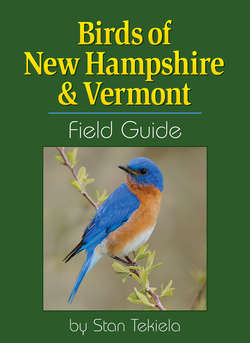Читать книгу Birds of New Hampshire & Vermont Field Guide - Stan Tekiela - Страница 29
На сайте Литреса книга снята с продажи.
Оглавлениеsoaring
juvenile
Turkey Vulture
Cathartes aura
SUMMER
| Size: | 26-32" (66-80 cm); up to 6-foot wingspan |
| Male: | Large bird with an obvious red head and legs. In flight, the wings appear two-toned: black leading edge with gray on the trailing edge and tip. The tips of wings end in finger-like projections. Long squared tail. Ivory bill. |
| Female: | same as male |
| Juvenile: | similar to adult, with a gray-to-blackish head and bill |
| Nest: | no nest, or minimal nest on a cliff or in a cave; 1 brood per year |
| Eggs: | 1-3; white with brown markings |
| Incubation: | 38-41 days; female and male incubate |
| Fledging: | 66-88 days; female and male feed young |
| Migration: | complete, to southern states, Mexico and Central and South America |
| Food: | carrion; parents regurgitate for young |
| Compare: | Bald Eagle is larger and lacks two-toned wings. Unlike the Bald Eagle, Turkey Vulture holds its wings in a slight V shape during flight. |
Stan’s Notes: The vulture’s naked head is an adaptation to reduce risk of feather fouling (picking up diseases) from carcasses. Unlike hawks and eagles, it has weak feet more suited to walking than grasping. One of the few birds that has a developed sense of smell. Mostly mute, making only grunts and groans. Seen in trees with wings outstretched, sunning itself. Recent studies show this bird is closely related to storks, not birds of prey.
